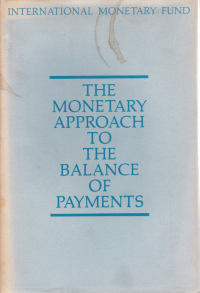 Witteveen's folly
Part 1
Hector McNeill1
SEEL
Macroeconomic management, before the Keynesian policy model existed, used flexible wages as the way to manage the balance of payments and "state of the economy". In 1975 Denis Healey rejected the Keynesian approach and in 1976 sought an IMF loan to intensify already imposed policy.
The IMF conditions, agreed to with Johannes Witteveen, the Managing Director of the IMF, returned the UK to the pre-Keynesian policy model of setting the balance of payments as a target and using labour wages to compensate for poor productivity.
The result was 45 year journey characterized by an increasing real incomes depreciation trap culminating in the UK's extreme exposure to the 2008 financial crisis. Quantitative easing as the "solution" only exacerbated the state of affairs.
|
The rejection of Keynesianism
In 1975 not knowing how to handle the slumpflation crisis, Denis Healey reverted to the pre-Keynesian model with a budget that:
- Substituted full employment and demand with the balance of payments as the policy target
- Set cash limits on government programmes except social programmes
- Reduced public spending where deemed not to be unmeasurable beneficial
- Made income policy voluntary knowing this would result in a decline in the standard of living
This precipitous decision was the result of the Treasury, also not understanding the solution to slumpflation, overestimating the borrowing requirement of the government. Therefore, fearing a "run on the pound", Denis Healey requested a loan from the International Monetary Fund (IMF). This was very unusual for so-called developed nations to make such requests. Having said that, the IMF had recently advanced loans to Hungary, Latvia and Iceland. However, the UK was another scale altogether. In the case of the United Kingdom, Johannes Witteveen, the Managing Director of the IMF took personal control of these proceedings and attended meetings in London concerning the conditions. The conditions were simply an intensification of those already making up Healey's policy.
What was of note was the resistance of Germany and France to following a similar route. The Germans had a better appreciation of what was at stake and this was supply side productivity. Based on a centuries long tradition of apprenticeships and technical education, Germany's strong balance of payments was the result of a massive accumulation of tacit knowledge and a flow of technological innovation.
The British educational system and the combination of a visceral and amateurish approach to industrial relations and the human resources skill base (tacit knowledge) meant that insufficient consideration was given to incentives to encourage technological and human resources investment.
Spreading the word
The fact that Healey had made the balance of payments a policy target was unusual at that time and this had a reinforcing effect on this aspect of IMF policy. Delighted with having managed a loan to the UK, making the balance of payments the main policy target, as a feather in his cap, Witteveen authorized the publication of a book in 1977, entitled, "The Monetary Approach to the Balance of Payments" by the IMF. Typical of IMF publications this consists of a series of very academic articles by IMF staff members based on a mass of statistics and simple mathematical formulae which discuss the relationships between monetary policy and the balance of payments. There is no reference to the real economy or the specific conditions within the supply side goods production sectors that, in themselves, can improve the balance of payments situation on a sustained basis. As in the case of Milton Friedman's assertions on cause and effect which have since been disproven, the papers in this publication constituted a recipe for disaster because there are no auxiliary policy actions identified and designed to encourage rises in productivity, as in the case of Germany. As a result the status of real wages and therefore aggregate demand, is entirely dependent upon centralized dictats which only look at the balance of payments in a vaccum, in monetary balance terms. in themselves, can improve the balance of payments situation on a sustained basis. As in the case of Milton Friedman's assertions on cause and effect which have since been disproven, the papers in this publication constituted a recipe for disaster because there are no auxiliary policy actions identified and designed to encourage rises in productivity, as in the case of Germany. As a result the status of real wages and therefore aggregate demand, is entirely dependent upon centralized dictats which only look at the balance of payments in a vaccum, in monetary balance terms.
I did review this book when it was published in 1977 (see the faded cover right, coffee stains and all) and found nothing of value in it. It occurred to me today that this might have been because by 1976 I had completed the development of the real incomes approach logic and I might have been overly dismissive. Just to check, in the light of my accumulated understanding of this topic in the 44 years since my first look, I completed another review today. It really is surrealistic in the sense of being not linked to reality, a next to useless analysis because it ignores the actual relationships between people, technology and survival. The contributions to the book do not consider the main contributing factors to the balance of payments equilibrium which a working population and managers can effect and therefore the contributions fail to provide any practical indications as to the options for policy incentives to bring about beneficial change.
Too much of the output on economics is academic in the sense of being connected with the analysis of highly restricted topics but not concerned with the provision of practical, evidence-based guidelines on how to achieve sustained economic development.
The second part of this article, in preparation, explains how Witteveen's decisions led to a failure to address the petroleum and hydrocarbon consumption issues that arose in the 1970s. This required an expansion in petroleum substitution technolgies, but Witteveen's decisions led to an expansion in the power and financial interventions of OPEC countries, and in particular Saudi Arabia's worldwide expansion of financial and political influence.
1 Hector McNeill is director of SEEL-Systems Engineering Economics Lab
All content on this site is subject to Copyright
All copyright is held by © Hector Wetherell McNeill (1975-2021) unless otherwise indicated
|
|
|
|
|